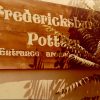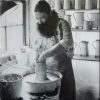#5 is a series
| Still figuring out life 40 years on… |
Ray picked me up from the coach station when I returned to England a few months later and drove me to the pottery. He told me that a few things had changed in the interval…some bloke by the name of Toff Milway had been given a job…and the caravan I was to stay in…and he’d finished off the salt kiln that I thought that I would be working on. This did not endear the man to me, and when we arrived, although it was late on a dark Saturday evening, Mr. Milway was at work in the workshop and Ray took me in to introduce us. My memory was that he barely grunted a greeting and kept on working. I was quite put off the man..little did I know that I was being put to a test that I think it’s safe to say I eventually passed and I never would have guessed that this man would become my best friend. My next memory is of Toff presenting me with Stephen Potter’s book ‘One-Upmanship’. This is a tongue-in-cheek novel about the rules of engagement for an English gentleman in the game of life. The book set the tone for my entire stay at the Pottery…it was not a place for the faint of heart! You never knew when the next prank was to be pulled or when someone was laying some sort of verbal trap. I don’t think that the British really believe that we Americans have much of a sense of humor about ourselves (I’m inclined to agree in general), but I’ve never been able to take myself too seriously and this served me well. One of the earliest excitements occurred in the wee hours of the morning of my 24th birthday. 6AM found me awoken from my deep sleep to the sound of gunshots…once I’d gotten off of the floor, sans glasses and clothes, I peeked out the window to see my mates standing just a few feet from me firing a 24 gun salute over the top of my caravan. Between volleys they were laughing like madmen! This led to many other birthday pranks that are well worth the telling, but must be saved for another time. Here’s a teaser…chickens and fireworks, exploding cigars and electrical shocks all played a part!
My job was a simple one really; I was to do whatever needed doing to support the team of throwers. In addition to making tea, which I wrote about earlier, I stacked the wood for the kiln, waxed and glazed pots, loaded and unloaded kilns, washed kiln shelves (140 for each firing which we did every 2-3 weeks) and sold pots from the showroom. One of my favorite times was firing…the workday ended at 4:30pm and everyone went home including Ray, who would nip across to the house to have his evening tea (which, of course means a light meal when it’s mentioned at this time…they say these things just to confuse us!) and leave me in charge. This was the beginning of my love of wood firing and as you know it remains a passion of mine.
When Ray returned he often brought with him a couple of Newcastle Brown Ales and would then direct me as I alternately stoked each firebox through to the end of the firing. There was plenty of time to talk about anything under the sun, and it was in these very quiet and precious hours that I grew to know him. Ray had a strong personal ethos and faith and this informed his ideas about the world. I once asked him what the biggest change he had seen during his years there. I suppose in my over earnest way I was expecting some deep philosophical response. Instead, he commented on the difference in the view of the hills that rise above Winchcombe. When he first arrived there all the roads were paved with crushed Cotswold stone, beautiful yellow lines crisscrossing the escarpment, but eventually they were paved with tarmac and to his eye, the black lines they made just didn’t please. He was a true countryman, an avid gardener and ever the artist. a word I am sure he would reject as being too pretentious. He preferred the word useful to describe his work rather than functional for much the same reason.
He once said that he saw his life’s work as refining the ideas that he had absorbed from his mentor, Michael Cardew, but I reject this as an oversimplification. He was an innovator, a compulsive tester and thinker and he contributed mightily to the encyclopedia of 20th century pottery knowledge.
It was exciting to work alongside he and Toff as they began figuring out salt glazing. I learned so much listening to the conversation as we examined the results of those early firings, both the failures and successes. He and Toff had a special bond and it was my great privilege to be included. Ray’s son Mike had just begun to manage the business as Ray was reaching his ‘official’ retirement age ( he made pots for 30 more years!) and he wouldn’t let us spend time on the salt kiln during business hours, so we 3 were often together in the evenings and week-ends, a total immersion for me that hasn’t really lessened all these years later.
This was the last great heyday of the pottery…there was a huge demand for the work and we were often packing pots for London or Macy’s in New York City or to be sent to the continent and there was a steady stream of visitor’s to buy pots directly. Ray believed that pots should be affordable to most anyone and as a result the pots remain accessible in a way that contemporary potters, usually working alone, can’t do. He held that idea as sancrosanct and even as the world around him changed drastically, he never wavered.
 |
| Tree |
 |
| Georgie’s garden |
 |
| Rogue sheep in the orchard |
 |
| Ancient thatch |
I’ll do my best to wind up this trip down memory lane tomorrow. If you’re still hanging in there, thanks.I don’t usually read overlong blogs myself, but this has been nothing but pleasure for me. I’ve meant to do this for a long time.






